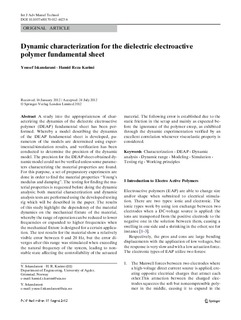| dc.contributor.author | Iskandarani, Yousef | |
| dc.contributor.author | Karimi, Hamid Reza | |
| dc.date.accessioned | 2012-10-19T10:21:20Z | |
| dc.date.available | 2012-10-19T10:21:20Z | |
| dc.date.issued | 2012 | |
| dc.identifier.citation | Iskandarani, Y., & Karimi, H. R. (2012). Dynamic characterization for the dielectric electroactive polymer fundamental sheet. International Journal of Advanced Manufacturing Technology, 1-10. doi: 10.1007/s00170-012-4423-6 | no_NO |
| dc.identifier.issn | 0268-3768 | |
| dc.identifier.uri | http://hdl.handle.net/11250/136906 | |
| dc.description | Published version of an article published in the journal: International Journal of Advanced Manufacturing Technology. Also available from the publisher at: http://dx.doi.org/10.1007/s00170-012-4423-6 | no_NO |
| dc.description.abstract | A study into the appropriateness of characterizing the dynamics of the dielectric electroactive polymer (DEAP) fundamental sheet has been performed. Whereby a model describing the dynamics of the DEAP fundamental sheet is developed, parameters of the models are determined using experimental/simulation results, and verification has been conducted to determine the precision of the dynamic model. The precision for the DEAP sheet-obtained dynamic model could not be verified unless some parameters characterizing the material properties are found. For this purpose, a set of preparatory experiments are done in order to find the material properties "Young's modulus and damping". The testing for finding the material properties is requested before doing the dynamic analysis; both material characterization and dynamic analysis tests are performed using the developed testing rig which will be described in the paper. The results of this study highlight the dependency of the material dynamics on the mechanical fixture of the material, whereby the range of operation can be reduced to lower frequencies or expanded to higher frequencies when the mechanical fixture is designed for a certain application. The test results for the material show a relatively visible error between 0 and 20 Hz, but the error diverges after this range was stimulated when exceeding the natural frequency of the system, leading to nonstable state affecting the controllability of the actuated material. The following error is established due to the static friction in the setup and mainly as expected before the ignorance of the polymer creep, as exhibited through the dynamic experimentation verified by an excellent correlation whenever viscoelastic property is considered. | no_NO |
| dc.language.iso | eng | no_NO |
| dc.publisher | Springer | no_NO |
| dc.subject | characterization | no_NO |
| dc.subject | DEAP | no_NO |
| dc.subject | dynamic analysis | no_NO |
| dc.subject | dynamic range | no_NO |
| dc.subject | modeling | no_NO |
| dc.subject | simulation | no_NO |
| dc.subject | testing rig | no_NO |
| dc.subject | working principles | no_NO |
| dc.title | Dynamic characterization for the dielectric electroactive polymer fundamental sheet | no_NO |
| dc.type | Journal article | no_NO |
| dc.type | Peer reviewed | no_NO |
| dc.subject.nsi | VDP::Technology: 500::Materials science and engineering: 520::Polymer and plastics: 523 | no_NO |
| dc.source.pagenumber | 1-10 | no_NO |
| dc.source.journal | International Journal of Advanced Manufacturing Technology | no_NO |
